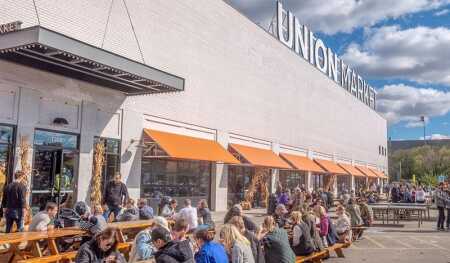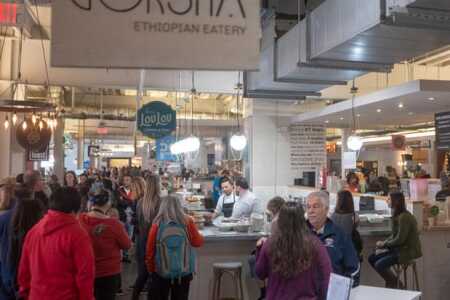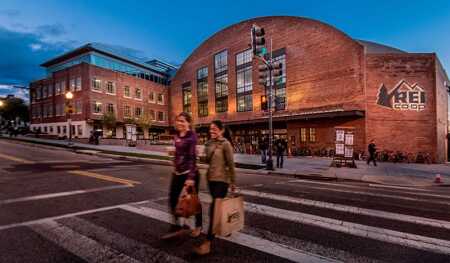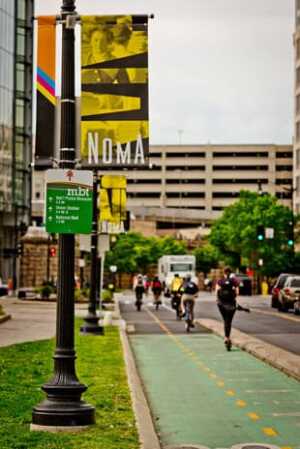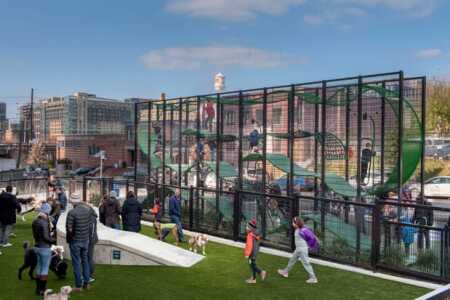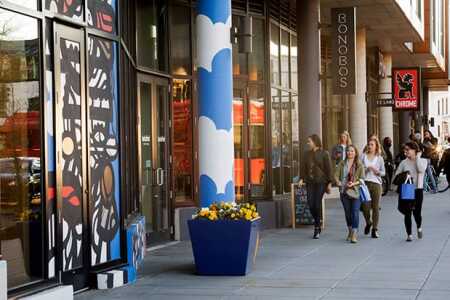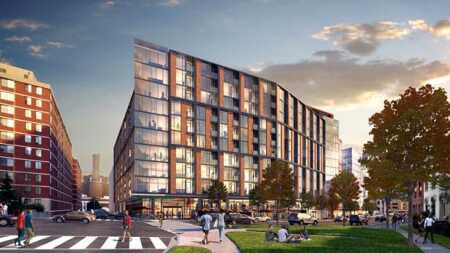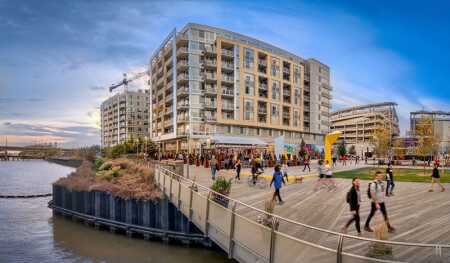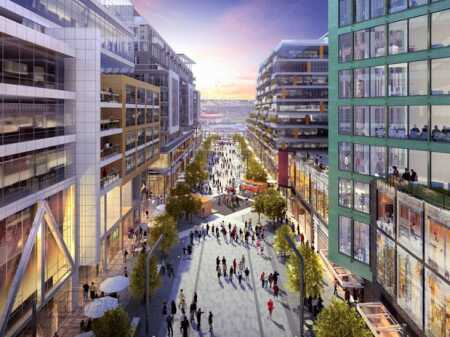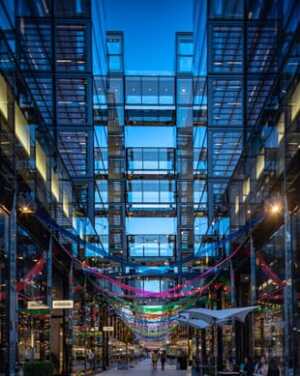This article appeared in the Fall issue of Urban Land on page 155.
“Hip” and “cool” are attributes not traditionally associated with the U.S. capital. But over the past two decades, Washington, D.C., has undergone rapid revitalization, attracting more than 120,000 new residents and billions of dollars in private and public investment. Fast-growing walkable neighborhoods are located throughout the city and beyond its borders into the Maryland and Virginia suburbs. Some D.C. neighborhoods are rising from the ruins of the 1968 riots. Others occupy former industrial land, train yards, warehouses, federal tracts, and a sprawling wholesale food market.
Many factors have spurred this transformation. Relocation of federal and city agencies from within D.C. and Northern Virginia brought thousands of jobs to areas that had little commercial activity. Development has been spurred by improvements to public transportation, theaters, sports venues, and even an enormous new sewer tunnel that has improved the Anacostia River’s water quality.
Despite its benefits, this rapid urban growth has a downside—displacement of longtime residents due to skyrocketing housing costs and other factors. In Washington, this phenomenon has a distinctly racial aspect: according to the Urban Institute, the African American share of the city’s population fell from 70 percent in the 1970s to 48 percent by 2016.
Mayor Muriel Bowser has set a goal of adding 36,000 new homes, one-third of them affordable, in the District by 2025. The mayor’s affordable housing investment includes $100 million in annual funding for the city’s Housing Protection Trust Fund. Public, private, and nonprofit groups including ULI Washington have launched initiatives addressing housing affordability.
This article focuses on larger neighborhoods within the city limits that are on a growth curve with substantial new housing, retail space, and amenities. Not included are more-established neighborhoods such as Georgetown, Capitol Hill, Dupont Circle, Logan Circle, and Foggy Bottom. Nor does the article cover the many walkable urban nodes in the Maryland and Virginia suburbs or the evolving office market.
A person strolling down city streets could find young workers on scooters gliding past construction cranes, anticipating the next new chef-driven restaurant, yoga studio, or Trader Joe’s grocery store. D.C.’s iconic go-go music, as pioneered by the late Chuck Brown in the 1970s, could be pumping from storefront speakers, with high energy and a throbbing beat that goes and goes. But the funk might be drowned out by jackhammers clearing ground for a new apartment building with the latest innovations in pet care and package storage.
Union Market
It has kombucha, Korean tacos, ramen, oysters, fish, crepes, wings, sushi, empanadas, vegan falafel, Neapolitan pizza, Venezuelan arepas, craft beers, an 88-year-old butcher shop, fresh produce, and lots of coffee. You can go there to watch art movies in a pop-up theater with a classic vibe or attend a book signing at the Politics & Prose bookstore. Watch Venus Williams play tennis on the world’s first professional sports rooftop stadium, or dine at one of two Michelin Guide restaurants—Masseria and Bidwell. Discover African fashions, rent creative coworking space, or live in new apartments minutes from Metro transit stations.
This is Union Market, a 45-acre (18 ha) historic urban development anchored by an eclectic food hall that opened in 2012 and now draws nearly 3 million visitors annually.
“In 2007, a friend called me to look at an empty lot here, where wholesale food vendors had operated since 1931,” recalls EDENS chief development officer Steve Boyle. “Just across the train tracks, we could see 22 cranes in NoMa [the North of Massachusetts Avenue area]. We felt that this site, as large as New York City’s Meatpacking District, could have a micro impact on the local community and a macro impact on the city.”
EDENS started investing in the area that same year, when some 90 separate property owners were in place. In 2009, the D.C. Council created a small area plan allowing for 8 million square feet (743,000 sq m) of mixed-use development.
Union Market provided a “laboratory” for EDENS chief executive officer Jodie McLean to actualize the vision that she explained in a 2017 Harvard Business Review article co-written by urban theorist Richard Florida.
“Inclusive prosperity is the idea that the opportunity and benefits of economic growth should be widely shared by all segments of society,” they wrote. “The Union Market district would need to create jobs, engage the surrounding community, inspire connection between the existing neighborhood and the broader city, preserve historical identity, and incubate entrepreneurship—all while making economic sense as a development.”
It is working without displacing residents, because none were living there. Already the Union Market district has created over 700 new jobs, launched more than 50 businesses, and added over 900 new residences. EDENS takes pride in the numbers of minority- and women-owned businesses, internships and apprenticeships, community events, and an extensive arts program that includes a mural by Yoko Ono. The district maintains an authentic feel, with preservation of the market’s historic core and many wholesale vendors still operating there.
The Edison, LCOR’s 188-unit apartment building with a street-level Trader Joe’s grocery store, opened in 2017, followed by two more projects that opened this year—the Highline (315 units) and the Batley (432 units). On the ground floor of the Batley is La Cosecha, EDENS’s contemporary Latin market with over 20,000 square feet (1,900 sq m) of culinary, retail, entertainment, and community space.
More than a dozen additional projects are in the development pipeline. Four parcels totaling over 1 million square feet (93,000 sq m) will be developed by JBG Smith in partnership with adjacent Gallaudet University, an institution of learning, teaching, and research for deaf and hard-of-hearing students. The project will follow DeafSpace principles such as creation of wide sidewalks that accommodate pedestrians conversing in sign language.
The Union Market effect is spreading in all directions. About a block south of the area’s Florida Avenue boundary—technically in NoMa—the 1940s-era Uline Arena was being used as a trash transfer facility when it was acquired by Douglas Development in 2004. Famous for hosting the Beatles’ first U.S. concert in 1964, the barrel-shaped behemoth was redeveloped in 2016 as office and retail space and now is home to outdoor-gear retailer REI’s fifth flagship store.
Douglas Development, headed by Douglas Jemal, also paved the way for revitalization of Ivy City, just one mile (1.6 km) up New York Avenue from Union Market. In 2011, charmed by the glass block and elaborate cupola of its streamline moderne design, Jemal acquired a six-story, 74-year-old shuttered department store warehouse. Now, Hecht Warehouse features 300 apartments and 125,000 square feet (12,000 sq m) of retail space, anchored by a MOM’s Organic Market. Ivy City’s new restaurants, breweries, and concert venues draw lively nighttime crowds. Car-sharing services fill in for the dearth of reliable public transportation.
From Nowhere to NoMa
Twenty years ago, there was no wrong side of the railroad tracks emanating from Union Station in northeast D.C.—because neither side was a pretty sight. Uline Arena was covered in graffiti. An intrepid investor encountered a corpse in a weed-covered vacant lot. Century-old brick warehouses had been abandoned as trucking replaced freight rail for delivering goods to the city.
Under the leadership of then-mayor Anthony Williams and the District’s nonvoting congresswoman Eleanor Holmes Norton in the late 1990s, the Washington Metropolitan Area Transit Authority (WMATA) planned its first infill Metrorail station in the area that was being rebranded as NoMa. Opened in 2004 and renamed NoMa–Gallaudet University in 2011, the station soon had an imposing new next-door neighbor: the 422,000-square-foot (39,000 sq m) headquarters for the U.S. Bureau of Alcohol, Tobacco, and Firearms, designed by Moshe Safdie, which brought thousands of employees to the emerging neighborhood.
Mixed-use development soon took off. Today NoMa boasts some 10,000 residents, 54,000 employees, 6,400 new and soon-to-be-delivered apartments, nearly 13 million square feet (1.2 million sq m) of class A office space, three hotels, and more than 370,000 (34,000 sq m) of retail space. People flock to restaurants Laos in Town and the Eleanor, Streets Market grocery and bar, Wunder Garten beer garden, Red Bear Brewing, and other hot spots. An astounding 86 percent of residents walk, bike, or take public transit to work, according to the NoMa Business Improvement District (BID).
Robin-Eve Jasper, president of the 12-year-old NoMa BID, credits the city, the community, and smart developers for NoMa’s success. “These are savvy developers who understand the value of collaboration, rather than seeing themselves as competitors,” she says. “We also have the city’s most permissive zoning, so investors knew that they could put their money to work with little entitlement risk.”
As dense development progressed with no green space in sight, the BID launched the NoMa Parks Foundation in 2012. “We received a $50 million grant from the city to acquire land and build parks,” Jasper says. “We consider it a sacred public trust to be given this money to create parks that will exist, hopefully, for many generations.” NoMa’s fourth and largest park, under construction for 2020 completion, will comprise 2.5 acres (1 ha) adjacent to NoMa’s northern edge, bordering the largely residential Eckington neighborhood.
Slower to develop than the area south of New York Avenue, this slice of NoMa will have more than 1,600 apartments and 173,000 square feet (16,000 sq m) of retail development by the end of 2020. Eckington Yards, a JBG Legacy Fund development, comprises 457 rental apartments and 224 condominiums, along with NoMa’s first maker space and local food purveyor Union Kitchen Grocery.
With a Walk Score of 94, NoMa takes pedestrians seriously, as demonstrated by the NoMa Meander, a four-block pedestrian corridor fronting new mixed-use buildings. Street-level shopping and dining will be enhanced with features like pocket parks and public art. In fact, there is outdoor art throughout much of NoMa, including large sculptures, several dozen murals, and two dynamic pedestrian underpass light installations.
Rising from the Ashes
Perhaps nowhere is the District’s transformation more profound than the 14th Street corridor in the city’s Northwest quadrant. This was the commercial and entertainment center of the African American community until the 1968 riots that damaged or destroyed about 900 businesses and 700 homes. In the ensuing years, the corridor was plagued by prostitution, drugs, and violent crime.
Recovery was a long time coming. Metro’s Green Line was rerouted to serve the area, but the subway construction hurt already struggling businesses. In 1986, Mayor Marion Barry’s administration completed a 500,000-square-foot (47,000 sq m) city government office building in the heart of the former riot zone. From the 1970s through the 1990s, individuals and developers such as Jim Abdo, Monty Hoffman, and Chris Donatelli began redeveloping dilapidated commercial buildings and rowhouses.
The 2000 opening of a Whole Foods on P Street, N.W., set off a wave of growth that included apartments, condominiums, theaters, bars, nightclubs, and sought-after restaurants such as Le Diplomate and Compass Rose. The restored historic Lincoln Theater on U Street, N.W., and Ben’s Chili Bowl, which has operated continuously since 1958, are reminders of the corridor’s history as the city’s “Black Broadway.”
Now on the verge of being a victim of its own success, with chain stores replacing some homegrown hangouts, the 14th Street development boom is shifting eastward to Shaw. With churches on every block, this neighborhood was a national center of African American intellectual and cultural life—the home of Howard University, Duke Ellington, and Langston Hughes. Shaw’s main streets were scarred by the 1968 riots, but apartments there now command some of the city’s highest rents.
Shaw’s new era began in earnest with Roadside Development’s City Market at O, which won a 2015 ULI Global Award for Excellence. Spanning two city blocks, this 1 million-square-foot (93,000 sq m) project includes an 1881-vintage public market repurposed as a modern Giant grocery store, 639 market-rate and affordable apartments, a hotel, and additional retail space. ULI applauded how the project catalyzed nearly $1 billion of new investment in Shaw and increased property values by more than 500 percent.
The P Street Whole Foods opening prompted local developer JBG (now JBG Smith) to look at 14th Street and its environs. “Dupont and Logan circles had fragmented ownership, no large sites, and a historic overlay,” notes Kai Reynolds, the firm’s chief development officer. “But our research showed that demand was moving east. Many millennials were moving to Washington due to the robust job market, and housing demand in the area outstripped supply.”
In the wake of the Great Recession, JBG started acquiring land and assembling development parcels. By the end of 2015, the developer had delivered the District and the Louis on 14th Street, as well as three projects in Shaw. The Shay has 245 apartments and about 27,500 square feet (2,600 sq m) of retail space with a curated mix of shops including Warby Parker, ModCloth, and Bonobos. Atlantic Plumbing A, named for the site’s former occupant, includes 310 apartments, shops, artist studios, and a 10,000-square-foot (930 sq m) Landmark movie theater next to the 9:30 Club live music venue. The company attracted an affluent market segment with 13/U, a 129-unit boutique residence with monthly rental rates as high as $11,000, and Atlantic Plumbing B’s 62 condominiums.
Inspired by New York City’s Meatpacking District as well as Portland’s Pearl District, JBG Smith tapped New York architect Morris Adjmi to bring an industrial-chic vibe to its three Atlantic Plumbing buildings. The latest, Atlantic Plumbing C, is scheduled to be completed at the end of this year with 256 apartments and about 20,000 square feet (1,900 sq m) of retail space. Adjacent to that building, JBG Smith is partnering with MRP Realty and Ellis Development on 965 Florida Avenue, scheduled for completion at the end of the year with 433 apartments, 30 percent of which will be affordable, and a new Whole Foods grocery.
Riverfront on a Roll
The city’s largest redevelopment locus is Capitol Riverfront, spanning 500 acres (200 ha) on the western side of the Anacostia River. Sandwiched between a major east–west freeway and a polluted waterway, this area two decades ago was an unappealing mix of light-industrial uses, bus and taxi parking lots, risqué nightclubs, deteriorating public housing, and the walled-in Washington Navy Yard.
Now the area formerly known as “near Southeast” has some 35,000 employees and 10,500 residents; 6,500 new residential units with 7,600 under construction or in the development pipeline; two professional sports stadiums; 6.5 million square feet (604,000 sq m) of office space; and 480,000 square feet (44,600 sq m) of retail space, including more than 60 restaurants and two grocery stores. Ongoing city and federal efforts are successfully restoring the Anacostia River.
“This is one of the largest riverfront redevelopment sites in the country,” says Capitol Riverfront BID president Michael Stevens, “comparable to Boston’s Seaport, Hudson Yards in New York City, Mission Bay in San Francisco, and even London’s Canary Wharf.”
The riparian renaissance began in 1995, when the U.S. Department of Defense moved about 8,000 Naval Sea Systems Command employees from Virginia’s Crystal City neighborhood to the Washington Navy Yard. Government contractors followed, spurring construction of five new office buildings. In 2003, the U.S. General Services Administration, which manages the federal government’s real estate, awarded the 42-acre (17 ha) Southeast Federal Center site—housing various federal offices plus some abandoned Navy facilities—to Forest City Washington for a new urban mixed-use development called the Yards. JBG delivered a new 1.1 million-square-foot (102,000 sq m) U.S. Department of Transportation headquarters within the site in 2007. Forest City, now Brookfield, is on track to complete the Yards with some 1.8 million square feet (167,000 sq m) of office space, 400,000 square feet (37,000 sq m) of retail and dining space, and up to 3,400 residential units at buildout.
In addition to a greatly improved riverfront with a popular new park and trail, Capitol Riverfront has what other parts of the city do not: Nationals Park, the Major League Baseball facility that opened in 2008, and the recently inaugurated Audi Field, home to the D.C. United professional soccer team. The soccer stadium has been a game-changer for Buzzard Point, the Southwest D.C. subarea with the oddball name that has been embraced for its authenticity: 1,100 residential units are under construction there. Just south of Nationals Park, MRP Realty transformed the former Florida Rock concrete plant into Dock 79 with 305 apartments and the Salt Line, All Purpose Pizzeria, and Dacha Beer Garden restaurants. Directly north of the ballpark, local developer Jair Lynch is nearing completion of a Half Street project comprising 312 apartments, 127 condominiums, and 55,000 square feet (5,000 sq m) of retail space. Two more residential buildings are underway in the immediate area.
A 2018 RCLCO report found that the District has more than broken even on its $1.1 billion cumulative direct investment in the Capitol Riverfront neighborhood and is set to double its return on investment by 2025. Furthermore, each public dollar has leveraged $1.92 of private investment. Upon buildout in 2040, the area is expected to generate $1.1 billion in tax revenue each year.
Best of the Rest
Revitalization is going on citywide, virtually everywhere that an old fixer-upper or empty lot can be found. Here are a few standouts:
- CityCenterDC is a 2 million-square-foot (186,000 sq m) mixed-use redevelopment of the old Washington Convention Center site, covering five city blocks in the heart of downtown. A partnership headed by Hines and Archstone delivered most of the billion-dollar project in 2015. Envisioned as D.C.’s Rockefeller Center, CityCenterDC offers high-end condominiums and apartments that have attracted some big names, a large public plaza, luxury retailers, and dining options such as Momofuku, Milk Bar, and Centrolina.
- The Parks is a 3 million-square-foot (279,000 sq m) mixed-use redevelopment of 66 acres (27 ha) within Walter Reed Army Medical Center’s former campus in northwest Washington. Over the next 10 to 15 years, the master development team of Hines, Urban Atlantic, and Triden Development Group plans to deliver more than 2,100 residences and 150,000 square feet (14,000 sq m) of grocery-anchored retail space, along with office, hotel, health care, and educational uses.
- Mount Vernon Triangle has 7,000 residents, some 60 shops and restaurants, and easy access to the buzzing entertainment attractions of the city’s East End, including the Capital One Arena, home to the city’s professional basketball and hockey teams, and a new Apple megastore in the restored historic Carnegie Library, located across the street from the Walter E. Washington Convention Center.
- Historic Anacostia and other Far Southeast neighborhoods have the District’s highest poverty rates, but their lower land values are attracting investment while providing fertile ground for a thriving arts and small business scene. The former St. Elizabeth’s hospital site is undergoing massive mixed-use redevelopment; a professional basketball practice arena and U.S. Coast Guard headquarters already have been completed.
- H Street, Northeast, a shopping corridor that was hit hard by the 1968 riots, is now bustling with hundreds of new apartments and condominiums, a Whole Foods, the sparkling Atlas Performing Arts Center, the city’s first modern streetcar, and on-trend restaurants like Erik Bruner-Yang’s Toki Underground and Maketto.
- Adams Morgan, a longtime hub of edgy nightlife, has cleaned up its act but still offers abundant international cuisine and entertainment. The new LINE DC hotel, situated in a redeveloped Christian Science church, features two restaurants by Bruner-Yang and one by Baltimore’s Spike Gjerde.
- Brookland, a.k.a. “Little Rome,” is home to Catholic University of America and the largest Catholic church in North America, the Basilica of the National Shrine of the Immaculate Conception. Brookland’s Metrorail stop and the presence of thousands of students have spurred mixed-use development, such as the 1 million-square-foot (93,000 sq m) Monroe Street Market by the Bozzuto Group, Abdo Development, and Pritzker Realty Group. The project includes an Arts Walk with 27 artist studios and a 3,000-square-foot (279 sq m) workspace for artists.
LESLIE BRAUNSTEIN is principal of LHB Communications, a public relations firm in the Washington, D.C., area.

